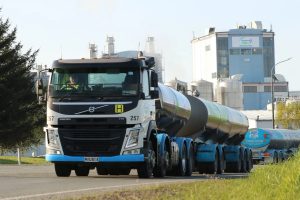
The country’s largest dairy company has raised its forecast payment to farmers four times this season as tight milk supply underpinned demand for New Zealand’s biggest export commodity. But it lowered its forecast earlier this month after prices for whole milk powder, a key driver of the milk price, fell as Covid-19 lockdowns in China, an economic crisis in Sri Lanka and the Russia-Ukraine conflict dented short-term demand.
Fonterra expects to pay farmers between $9.10 and $9.50 per kilogram of milk solids this season. The $9.30 per kgMS midpoint, which farmers are paid off, would be the highest milk payment since Fonterra was formed in 2001 and would inject almost $14 billion into New Zealand’s economy.
Analysts are now turning their attention to next season, with prices forecast to remain elevated. Fonterra is expected to announce its opening milk price for next season when reporting its third-quarter results on Thursday.
Westpac senior agri economist Nathan Penny expects next season’s milk price to remain high at $9.25 per kgMS as demand improves and supply remains tight.
“We still expect this dip in Chinese demand will prove temporary as Covid restrictions will eventually ease,” he said in a note last week following the latest global dairy trade auction.
China’s Covid-19 restrictions were starting to wind back and daily case numbers were falling, he said.
“Fundamentally, global supply remains tight and we expect this tightness to support prices over the second half of calendar 2022 and into 2023,” Penny said. “Global grain feed prices remain very high and continue to put the squeeze on farmer margins in the US, Europe and Australia.”
The dip in the New Zealand dollar was putting the milk price on the front foot for the new season, he said, noting the currency had traded recently at US62c, a marked drop from around US68c just a month ago.
ASB economist Nat Keall said he remained upbeat about the outlook for dairy prices, with a $9.20 per kgMS forecast for next season.
“We’re still bullish on the price outlook – global supply remains very tight and demand is fairly robust,” Keall said in a note following the latest auction. “Recent economic data out of China have been soft and global growth forecasts have been revised down, but both China and the global economy more broadly are still in expansionary territory, and global dairy demand is still set to rise.
“Global dairy supply is still very, very tight, with no obvious signs of meeting that demand,” he said. “Our base case is still that prices will recover some ground over the NZ winter.”
Keall said the decline in the Kiwi dollar was also giving a big lift to his forecast, and had largely offset the fall in prices over the past couple of months, given Fonterra was probably about midway through its currency hedging for the next season.
Rabobank senior agricultural analyst Emma Higgins is due to publish her latest dairy seasonal outlook report this week, which will include a $9 per kgMS forecast for next season.
ANZ agriculture economist Susan Kilsby lowered her forecast for next season earlier this month by 80c to $8.50 per kgMS, saying commodity prices were anticipated to keep falling in coming months.
“Global dairy markets have been impacted by the economic consequences of the Shanghai lockdowns, which is being felt throughout Asia,” Kilsby said in a note.
“The near-term economic outlook in China generally is looking more clouded as global demand for manufactured goods starts to wane.The high prices buyers have been required to pay to secure dairy products in recent months have also had some impact on demand, particularly from poorer countries.”
Still, relatively low global milk supplies were expected to put a floor under prices later in the year, she said.
“We have seen some increases in global milk supplies in response to the high prices, but these are expected to be modest throughout the rest of 2022 as high input costs take the shine off strong milk prices,” she said.
“In the current environment where demand is weakening, any increase in output can put downward pressure on prices. For now, we remain relatively confident the supply response will not be excessive, but it is much harder to forecast demand.”
Kilsby expects dairy commodity prices will continue to fall for the next three to six months before stabilising.
“There is considerable uncertainty about how supply constraints and waning demand will balance out in terms of price movements,” she said.
“Global risks to demand are now outweighing relatively subdued global milk supplies. On balance, we anticipate further downwards pressure on commodity prices and farmgate prices. However, the overall tight supplies in the global food production system, along with muted incentives to increase milk production, mean prices are not expected to slide too far.
“This will help keep farmgate prices above their long-run average next season.”
While the New Zealand dollar had weakened in response to other central banks hiking interest rates, ANZ expects the Kiwi dollar to strengthen again to reach US69c at the end of this year.
BNZ senior economist Doug Steel said the current market strength and outlook suggests a record opening price forecast for the new season “maybe with a $9 handle”.
Fonterra’s opening price for the current season was a record breaker. This time last year, the co-operative announced an opening forecast for the current season of between $7.25 and $8.75 per kgMS, with a mid-point of $8 per kgMS. Its previous highest ever opening price was $7 per kgMS.
Still, Steel said there was uncertainty around global supply and demand that seemed assured to alter any initial forecast through the season and he expected Fonterra to outline a relatively wide forecast range.
“Whatever the forecast, local farmers will be weighing it up against rapidly rising costs,” he said.























